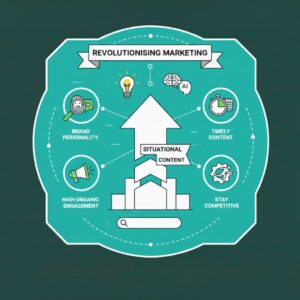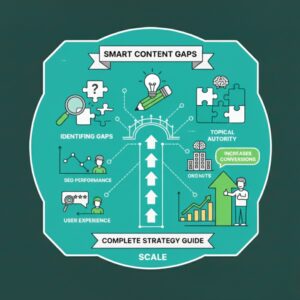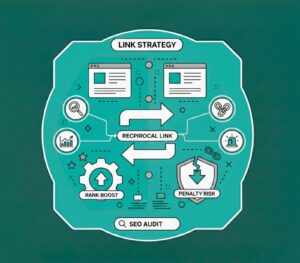Entity SEO Explained: Why It's the Beating Heart of Your Digital Marketing Strategy
Blogs | Category
Written By: Lauren Davison
Introduction
The old SEO playbook, which included stuffing keywords and chasing backlinks, has lost its effectiveness. Google has evolved. It now interprets intent, context, and the relationships between people, places, and brand entities. That shift means your brand’s visibility depends on how clearly it’s defined in Google’s knowledge system.
A well-structured entity SEO strategy for business growth is what ties your marketing together. It gives your brand identity, authority, and meaning across every digital touchpoint. Without it, your marketing has no real heartbeat only scattered tactics.
Table of Contents
Moving Beyond Keywords: What Entities Really Are
An entity is any real-world object or concept that Google can distinguish. Midland Marketing is an entity. So is the city of Birmingham. Even the service “Search Engine Optimisation” is one. Each connects within Google’s Knowledge Graph a massive web of related entities defining how information links together.
The purpose of Entity SEO is to make your business a recognisable and well-connected node in that web. When your entity is clear and consistent, Google understands what you do, who you serve, and why you matter. That’s how businesses move beyond keyword competition into sustainable digital authority.
The Vital Connection: How Entity SEO Powers Your Online Presence
A strong entity SEO strategy for business growth signals the four pillars of Google’s quality framework, such as Experience, Expertise, Authoritativeness, and Trustworthiness (E-E-A-T). It tells search engines that your brand is not just relevant, but reliable. Instead of chasing rankings for single keywords, you become the definitive source for complex, intent-driven questions.
This forms what marketers call a Trust Flywheel. As your brand earns credibility, visibility grows, and every mention adds more weight to your reputation. Over time, this mechanism builds real domain authority the kind that endures algorithm updates.
The Four Chambers of Your Strategy’s Beating Heart
Every successful entity’s SEO strategy for business growth runs on four core systems — each feeding the next. When one chamber weakens, the entire system loses rhythm. But when all four work together, your digital presence moves with purpose and power.
Chamber 1 — A Consistent and Clear Digital Identity
Start by unifying your brand’s core details.
- Keep Name, Address, and Phone Number (NAP) consistent across all directories.
- Add Schema.org markup to pages so search engines can interpret what your content means.
- Optimise your Google Business Profile with categories, services, and imagery.
These small but crucial steps tell Google exactly who you are — no confusion, no duplication.
Chamber 2 — Content That Builds Your Expert Profile
Great content doesn’t just inform; it defines your entity’s expertise. Build topical hubs that fully explore your services and link them internally. Add authorship and expertise signals through clear bylines and author bios that highlight experience and qualifications. Google recognises when a real expert is behind the words. Consistency in voice and theme helps Google associate your brand with key industry concepts. It is a vital step for entity optimisation for local businesses.
Chamber 3 — The Echo of Your Reputation
Google listens to how others talk about you.
Unlinked brand mentions in trusted publications, local news, and industry sites reinforce your authority. Next, build high-quality citations in relevant business networks. Listings on verified platforms like Yell, Clutch, or local Chamber of Commerce directories reinforce your legitimacy. This ecosystem of recognition forms the “echo” that strengthens your brand’s entity profile.
Chamber 4 — The Pulse of Public Sentiment
Reviews, social interactions, and engagement metrics keep your entity alive. Real customer reviews on platforms like Google and Trustpilot show authenticity. Regular, conversational social activity signals vitality. A brand that interacts is a brand that exists and Google reads those signals as proof of relevance.
Each chamber supports the others identity builds recognition, content builds authority, reputation builds credibility, and sentiment builds connection.
Together, they form the living system that powers every successful entity SEO strategy for business growth.
Weaving Entity SEO Into Your Existing Marketing
Entity SEO isn’t a side project. It’s the strategic thread that weaves through every marketing channel.
- Your PR builds citations and mentions.
- Your social content confirms your brand’s ongoing activity.
- Your technical SEO makes the entity readable to machines.
- Together, these layers reinforce your brand as a coherent digital identity.
When you plan campaigns, link each activity back to entity growth. Launching a new product? Align schema, PR, and author profiles to position that product within your entity network. The payoff: visibility that compounds instead of fading.
A Simple Starting Plan
- Audit your online listings and fix NAP inconsistencies.
- Implement structured data using Schema.org.
- Create one high-value content hub that ties to your main service.
- Gain one strong external mention — local news, industry blog, or guest feature.
- Request reviews and reply to everyone publicly.
Conclusion: Building a Strategy With Heart
Entity SEO is what transforms a collection of marketing tasks into a unified system. It gives your brand structure, relationships, and long-term resilience. When your entity is clear, every marketing action reinforces the same signal of trust. Each piece of content and every PR effort points in the same direction.
If you’re building a business that values authority over shortcuts, then an entity SEO strategy for business growth is the work that matters most. It’s not about chasing algorithms. It’s about defining your brand so clearly that Google and your customers recognise it instantly.
Ready to inject a powerful, strategic heart into your marketing? Let’s shape your entity, strengthen your signals, and build a reputation that endures with the help of Midland Marketing.
Reach out to us for more information.
Frequently Asked Questions
- Is Entity SEO only important for large corporations?
No. Smaller and local businesses often see faster results because entity clarity boosts local search visibility.
- How is Entity SEO different from technical SEO?
Technical SEO makes your site accessible. Entity SEO makes your brand understandable. Both are essential.
- What’s the first step to building our entity?
Start with consistency — align your NAP and schema data across every listing.
- Can Entity SEO help a local business in Birmingham compete with national chains?
Yes. Strong local entity signals — verified GBP, local mentions, and reviews — can elevate your visibility beyond competitors with bigger budgets.
- How long until results appear?
Initial visibility gains can appear within weeks; stronger authority compounds over several months of consistent effort.

Written by - Lauren Davison
Introducing Lauren – one of our content writers who has a flair for SEO and creative strategy!
With a Master’s Degree in Creative Writing, Lauren has niched down into SEO and content writing.
Outside of work, she loves watching the darts, reading and the pub on the weekend.
Want some more?
Latest Insights & News

Revolutionising Marketing: The Rise of Situational Content Strategies
Situational content strategies involve tailoring content to specific moments, contexts, or audience behaviours. By aligning content with real-time trends, seasonal needs, and user intent, brands can increase relevance, improve engagement, and strengthen SEO performance.

Smart Ways to Identify and Fill Content Gaps Fast: A Complete Strategy Guide
Content gaps refer to missing information, unanswered questions, or underserved topics in your existing content. Identifying these gaps helps you create targeted, high-value pages that improve search visibility, satisfy user intent, and outperform competitors.

Reciprocal Links in SEO: Do They Still Boost Rankings or Risk Penalties?
For the keyword “reciprocal links SEO,” focus on explaining how reciprocal linking works today. Reciprocal links are not harmful by default, but Google can flag excessive or manipulative link exchanges. To stay safe, only exchange links when they are contextually relevant, natural, and valuable to users.




